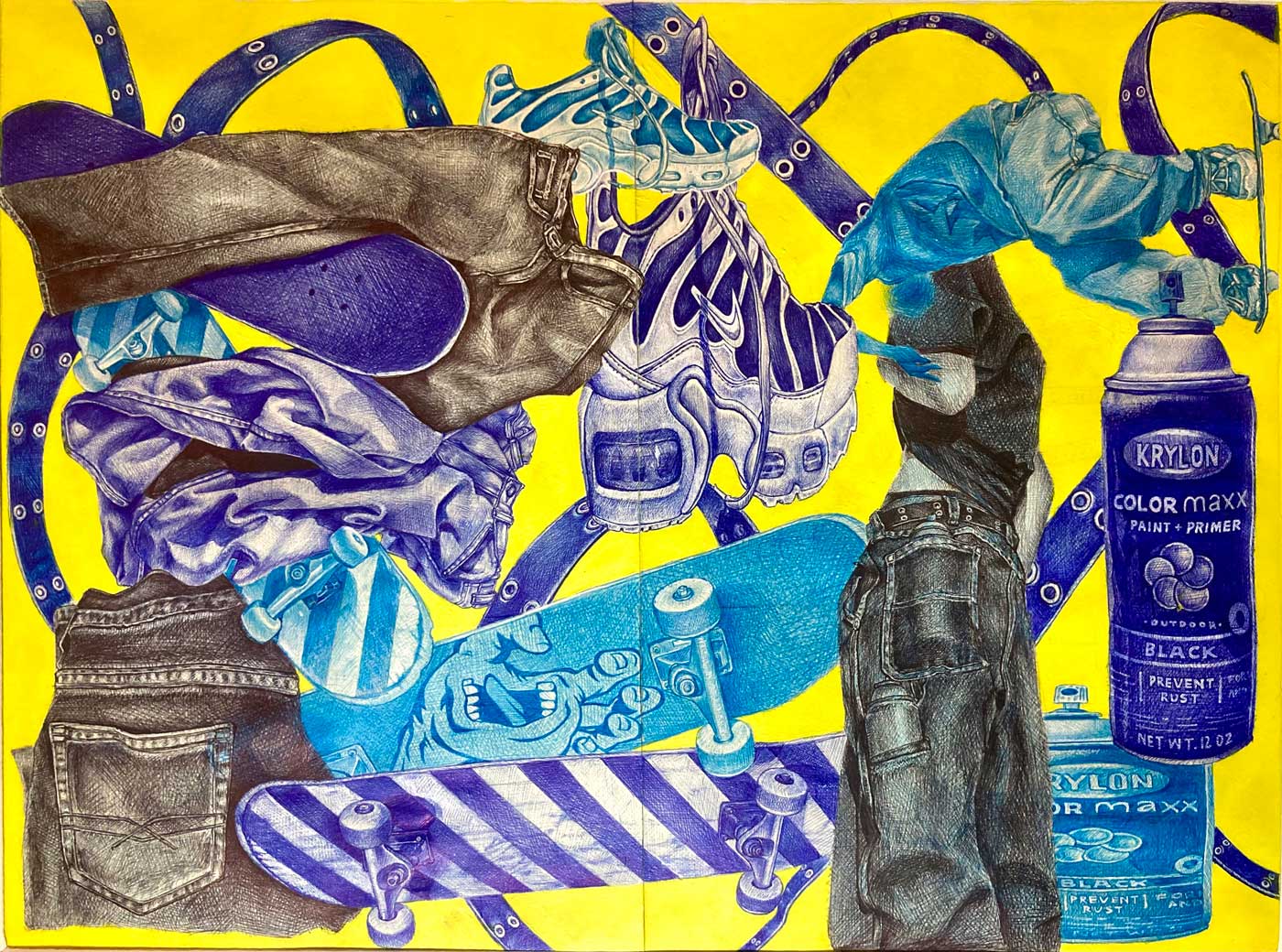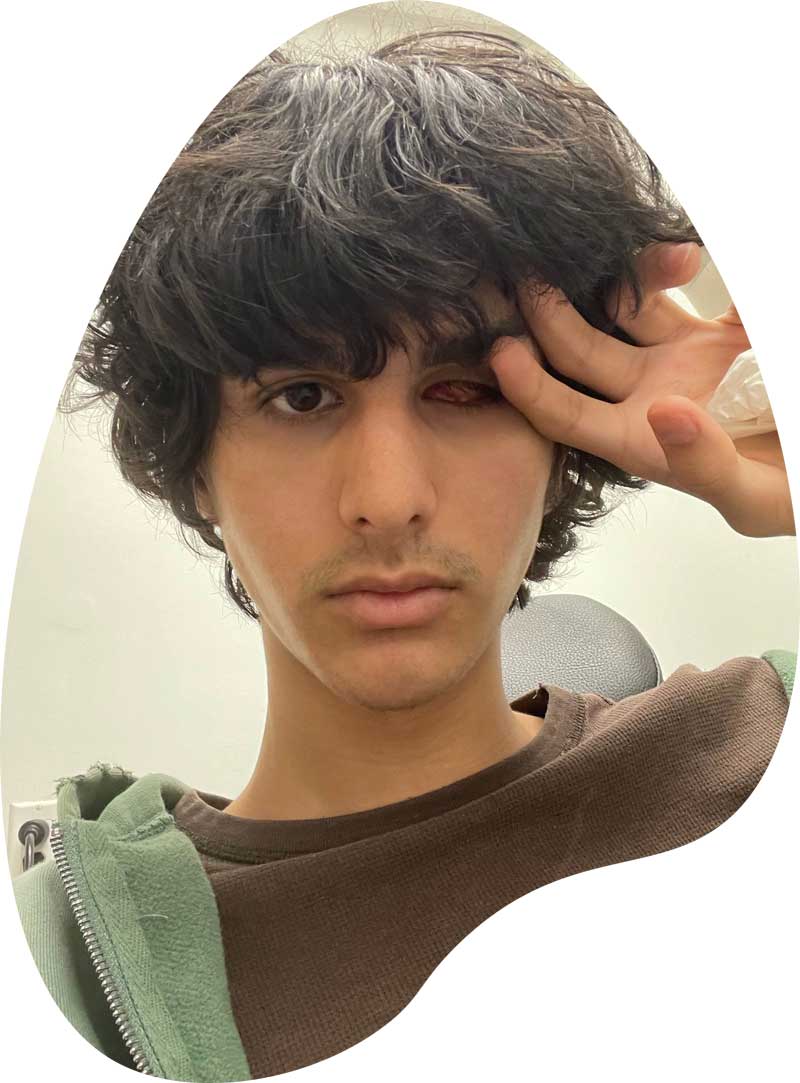


Fashion and Function
Height: 17" x Width: 19" | Material(s): Ballpoint Pen x Acrylic Paint x Pencil | Process(es): Took and manipulated reference photos and composed them digitally. I then rendered it on paper. | Idea(s): Shows the relationship between fashion and graffiti by showing the use in the clothes they wear. | Curatorial Note: Great sense of movement throughout the composition using ball point pen, pencil, and acrylic paint.
Marcel Rodriguez
Does your work reference or draw on a contemporary or historical artmaking style, practice, or tradition? If so, please explain.
Yes, my work draws on both contemporary and historical artmaking styles and traditions, using elements from various movements like graffiti and pop art while also touching on subjects and ideas relevant to today.
How did this artwork relate to your sustained investigation inquiry?
This artwork showcases the relationship between fashion and graffiti/skateboarding. It relates to my inquiry by showing graffiti artists and skateboarders that might wear these clothes, and it visualizes the practicality/function behind it. Fashion and clothing plays a big part in these subcultures, and mainstream fashion/culture has drawn tons of influence from skateboarding and graffiti. This has allowed the artform of graffiti and the sport of skateboarding to become more recognized and respected within these last few years, which I felt was important to express.

Using a collage-like approach, I manipulated and distorted images, used techniques like foreshortening, experimented with compositions and added overlaid lettering to convey the essence of the art form.
How did you choose your inquiry?
My inquiry was chosen after brainstorming and revising several topics that I found interest in. The topic I ended up deciding on was the one I felt most inspired and passionate about. It was very close to me, which allowed me to draw inspiration and come up with ideas easily.
How did your art teacher support your artistic development?
Although my school doesn't have the largest art department, I was lucky enough to have teachers that cared about us and our artwork. They took the time to give great constructive criticism and put tight deadlines on us, which helped immensely when it came to working efficiently and developing our portfolios.
How did your school leadership (principal, assistant principal, guidance counselor, etc.) support your growth as an art student? This could be classroom visits, attending art shows, talking to you about your goals, etc.
My counselors in school visited our classroom and held meetings about our goals and futures. They always supported my goals and helped create plans and steps to achieve them.
What is your advice to other AP Art and Design students?
My biggest piece of advice I would give to other AP Art and Design students would be to spend time on choosing a good inquiry and find something you are interested in. Having to create 15 pieces within a year isn't easy, but it becomes a lot easier when you find interest in the artwork you're producing. Your inquiry is the base of your entire portfolio, and it's lacking; it's likely that it will show in the art. Having an inquiry that I was passionate about allowed me to find ideas easier and have a better creative vision as a whole.
Kayla J. Montizaan
Art Teacher
Somerset Preparatory Academy Homestead, Homestead, FL, USA
Teacher statement
Teacher statement
The AP Art and Design course supports inquiry-based personalized learning in the sustained investigation portfolio component. What strategies helped you guide students through inquiry?
To guide students through inquiry in the AP Art and Design course, I encouraged open-ended questions, fostered critical thinking, and supported self-directed exploration. I helped students connect their interests to artistic themes, provided regular feedback to refine their ideas, and emphasized the importance of reflection and iteration throughout their sustained investigation. This approach empowered them to take ownership of their creative process and develop a deeper understanding of their work.
How did you scaffold writing into the artmaking and thinking processes?
I scaffolded writing into the artmaking process by encouraging students to reflect on their creative choices, document their progress, and articulate their intentions. I provided prompts for journaling, artist statements, and critical analysis, helping students connect their visual work with their conceptual thinking. This writing practice allowed them to clarify their ideas, evaluate their artistic decisions, and develop a stronger narrative throughout their projects.
How did you support skill development AND inquiry in the AP Art and Design curriculum?
I supported skill development and inquiry by integrating hands-on techniques with open-ended projects that encouraged exploration. I provided targeted lessons to build technical proficiency, while also prompting students to ask questions, experiment with different mediums, and reflect on their creative process. This balance allowed them to refine their skills while deepening their conceptual understanding through inquiry-based learning.
How did you structure practice, experimentation, and revision into your AP Art and Design curriculum?
I structured practice, experimentation, and revision by setting clear milestones in the creative process. Initially, students engaged in skill-building exercises and exploratory projects to experiment with techniques and materials. As they developed their ideas, I encouraged regular feedback sessions and self-reflection, allowing students to revise and refine their work. This iterative process helped them grow both technically and conceptually throughout the course.
How do you support your students in the Selected Works portfolio component?
I support students in the Selected Works portfolio by guiding them through the process of selecting and refining their strongest pieces. I encourage them to choose works that reflect their growth, artistic voice, and conceptual depth. Through regular critiques and feedback, I help students analyze each piece’s context, meaning, and technical execution, ensuring that their final selections represent a cohesive and thoughtful body of work.
Marcel Rodriguez



